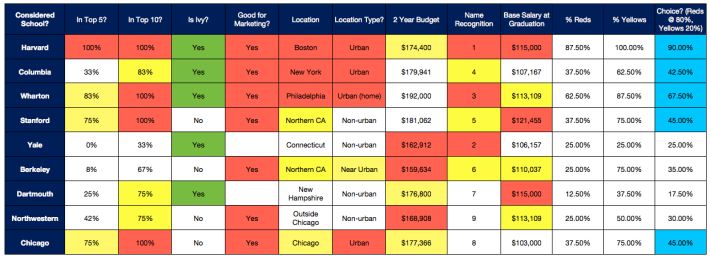One of the first tasks I have in my MBA plan is to nail down the top 5 programs I am targeting. I have been doing a lot of reading the past couple months to figure some of this out. There are so many different factors and different ranking systems, it is hard to know what to look at when making a decision. On one hand, I want to make sure I apply to enough schools where I will get in to at least one. On the other hand, I don’t want to waste my money applying at schools I may not want to go to.
This can be confusing. I began thinking more about my goal: to get into a top 10 MBA program. What exactly is a top 10 MBA program? Who says so? Which ranking do you believe? How much stock should you put into rankings anyway?
According to my plan, I don’t have to make a decision on my top 5 until April. However, I started to put some structure around how I am going to make that decision today so that I can focus any campus visits and energy on the schools that fit into the criteria that is important to me.
First I had to figure out what was important to me. Here is what I came up with:
- Location (either not far from home or someplace warm)
- Location type (prefer urban vs. not urban)
- Rankings (how often does the school fall into a top 5 or top 10 rank)
- Name recognition (this was really my own perception of name recognition – which I think would be similar for most HR folks in the area, which I plan to return to after school, better name recognition is preferred)
- Is the school good for a Marketing specialization (Does it appear in the top 10 of U.S. News’ Marketing MBA Specialization ranking)
- How expensive the school is (using published 2 year budgets, obviously less expensive is preferred)
- Base Salary at graduation (using averages published by the schools, the higher salaries are preferred)
To figure out the rankings, I first created a table of the past two years of published rankings data from the most popular (in my opinion anyway) MBA ranking publishers.
These are:
- Business Week
- Forbes
- Financial Times
- U.S. News & World Report
- The Economist
- Poets & Quants (which is a composite of the above – and weighted by the rankings that they think are most credible)
I highlighted any Ivy League Schools in Green. It is not exactly a factor that would fall into my decision making, but I think it is an interesting piece of information and might come into play if there was a tie-breaker scenario. Basically, this is the “snob” appeal of the school…sure, you can call me vain.
Here is the rankings matrix:
Next, I laid out all of the criteria that is important to me into another Matrix:

Red means this is the most preferable option in the criteria and yellow is a close second. White would be less than ideal. The ‘Top 5’ and ‘Top 10’ percentages are based on how often that school appears in the top 5 or top 10 rankings in the previous rankings matrix.
For Example: Harvard appeared as a top 5 program in every ranking in the matrix for the last two published years. Therefore, they are 100% ‘In Top 5’ and 100% ‘In To 10’. Booth appeared 100% of the time in the top 10, but only 75% of the time in the top 5.
Any school that appeared over 75% of the time was colored yellow. Any school that appeared 100% of the time was colored red.
The last three columns are where I did the actual analysis. There is a % Reds column, which means how often (as a percent) did that school get a box colored red. The next column is called % Yellows, meaning how often (as a percent) did that school get a box colored yellow or better (i.e. red). The last column is a weighted average of these columns. Reds are weighted at 80% and yellows are weighted at 20%. I colored in the top 5 scores in blue and….after all that, I think I have a good idea of my top 5!
In order, they are:
- Harvard (a long shot for me), with a score of 90%
- Wharton, with a score of 67.5%
- Stanford & Booth, tied with a score of 45%
- Columbia coming in 5th with a score of 42.5%
I have to say, I am a little surprised by some of the outcomes. If I had to guess before this analysis, I would have thought Berkeley would have ranked higher for me and I am not sure that Chicago would have been a front-runner on my list prior to this exercise.
All in all, very enlightening. I think now that I have a good idea of my top 5, I can focus my campus visits.
How would you/did you make the decision about where to apply? Is there anything I forgot to include that might be an important factor in my decision making process?
